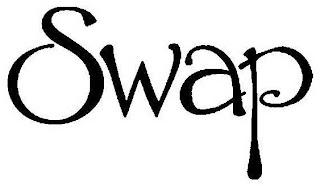Rejecting Opposer's CD-ROM Testimony, TTAB Dismisses SWATCH Opposition to SWAP for Watch Bands
The Board dismissed an opposition to registration of the mark SWAP in the stylized form shown below, for "watch faces, ribbon watch bands, slide pendants, and beaded watch bands," finding it not merely descriptive of the goods, and not likely to cause confusion with or to dilute the registered mark SWATCH for watches, clocks, and parts. Opposer Swatch failed to get into the record a significant chunk of testimony and evidence that might have changed the outcome. Swatch AG v. Bernard, Opposition No. 91169312 (February 23, 2011) [not precedential].

Testimony on CD-ROM rejected: Opposer got off on the wrong foot when it submitted testimonial depositions of five witnesses on CD-ROM. However, since August 31, 2007, CD-ROMS are no longer accepted. See Rule 2.126(b). So the Board refused to consider that testimony and accompanying exhibits.
Mere Descriptiveness: Swatch relied on certain statements made in discovery depositions of Applicant regarding the meaning of "swap," but the Board refused to accept the statements as admissions: "we construe the statements made in applicants’ discovery depositions as simply demonstrating a lack of understanding of the significance of descriptiveness versus suggestiveness as applied to applicants’ mark at a time when mere descriptiveness was not a ground for opposition in this proceeding."
The Board also pooh-poohed Swatch's dictionary and website evidence, finding that SWAP is at most suggestive of interchangeability, a feature of the goods.

Likelihood of Confusion Swatch claimed that its mark SWATCH is famous, but there was no testimony or evidence to support its assertions regarding sales, advertising and length of use of the mark. [Because the testimony and exhibits on CD-ROM were excluded]. The only evidence of fame consisted of some thirty print articles, but that evidence fell far short of establishing fame.
The Board found the goods to be partly identical, and it presumed that they travel in the same, normal channels of trade for those goods. It noted once again that when the goods are identical, a lesser degree of similarity is necessary to support a finding of likely confusion.
As to the marks, the Board found that "most importantly" the marks are "distinctly different in meaning."
Consumers are likely to note and understand the meaning of this common term [SWAP] because ... SWAP suggests that applicants' watch faces and watch bands are interchangeable and may be used to combine different colors and styles of watches. Inasmuch as SWAP has significance relating to applicants’ goods, consumers are likely to remember the meaning of SWAP as applied to those goods.
This significant difference in connotation, according to the Board, outweighed the "fact that the marks begin with the same three letters."
The Board next found that the goods, being unlimited as to price, would "include inexpensive products that normally would be purchased without a great deal of thought."
Balancing all the relevant du Pont factors, the Board ruled that confusion is not likely.
And so the Board dismissed the opposition.
TTABlog note: I suspect that Opposer Swatch will be contemplating a civil action for review of the Board's decision, under 15 U.S.C. Section 1071(b), which would provide Swatch with a trial de novo where it may submit the testimony excluded by the Board.
Text Copyright John L. Welch 2011.




0 Comments:
Post a Comment
<< Home